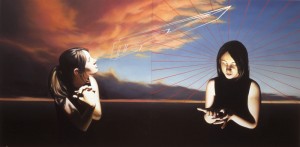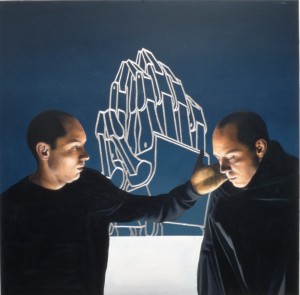IN THE GALLERY: Clone

Assumption and Delusion, 2002
Oil on Aluminium
120 x 240 cm

The Big Prayer, 2002
Oil on Aluminium
120 x 240 cm

Saints and Sinners, 2002
Oil on Aluminium
120 x 240 cm
Juan Ford
1 - 30 Mar 2002
Passion is marked by a dark desire to inhabit and enclose the body of the other, but it is also the need to illuminate the self by a coupling with something that is implicitly bound to us. The other in this sense is a dense screen that suggests the sublime as a vast pleasure of unknowing, something powerful beyond our grasp.
Juan Ford’s paintings investigate the infinite space of the unknown as a place of spiritual unfolding, and force an evaluation between what is quantifiable and that which cannot be measured. The geometric motifs in earlier works surface again as an incongruity alongside human emotion. The bodies in the paintings contort in subtle ways to suggest that a tension exists between mental and physical states of being, and mirror the distortions of the anamorphic engravings. Referring to both the cinematic gaze and self-consciousness on the part of the subjects, Ford averts their eyes or presents them engaged with an authoritative other out of view. The dreamlike, architectural terrains proffer difference as an absence reflected in the subjects as a place of disappearance or forgetting. Each painting appears as a single frame in a vast unfolding of human drama.
His paintings engage with the alliances that might be forged between divergent subject positions in a field of familiarity and strangeness. His depiction of the twin or clone draw us into historical readings of the grotesque, as that which is unnatural, abnormal and out of control; and current fears surrounding body replication through genetic engineering. Ford’s interrogation of the loss of self-identity through a sinister double recalls Sigmund Freud’s notion of das unheimliche – the uncanny, a fearful yet disturbing familiarity that surrounds things that we find strange. It is as though our first inexplicable experience was when we saw our self-reflection and the fear thereafter that someone might take our form.
Ford challenges the uniqueness of the self by undermining its singularity and offers instead a sensory flow between bodies, producing a self no longer contained in one body and one location. A dark cloud hangs over these isolated individuals who no longer know who they are or where they stand in a technological culture, which homogenizes form
His peaceful, yet disturbed subjects are invariably monstrous in their ability to evoke the uncanny divided self. Immense and incalculable, the simulacrum as unknown well of terror threatens to dissolve the self in an otherness that cannot be defined. His replicants and the obvious central divisions draw us into a duality. Yet the narratives suggest a mockery, offering instead an obfuscation of the borders and a narrowing of the great gulf between the original and the copy.
The paintings exhibit a poeisis, bringing the unnamable forth through gesture and recognition. Hands are invariable the nexus between self and other, good and evil, idea and manifestation. But ultimately the narratives portray a concern with constructed others that continue to threaten autonomy in a biotechnological future.
Julie Clarke, 2001
